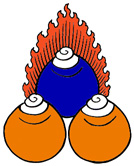| |

Studies
in
Buddhadharma
On Method
 Contents
Contents  SiteMap
SiteMap

"May I be a protector for
those without one,
A guide for all travellers on the way.
May I be a bridge, a boat and a ship
For all who wish to cross the water."
Śântideva
: A Guide to the Bodhisattva's Way of Life, 3:18
|
"Upâya" ("approach,
arrival") is skill in means or method. In the
Hînayâna, this skill is reflected
in the multiple techniques introduced by the
Buddha, and manifests
in his ability to adapt the Dharma to all kinds of people. Their
afflictive emotions, mental obscurations, delusions,
superstitions & hallucinations call for a pluralist teaching, one
able to guide a wide range of practitioners to
Dharma. However, method became part of
the "canon" only later.
|
First of all, "method" is skill in
expounding the Dharma, teaching in tune with the capabilities,
propensities & potentialities of practitioners, divided in lesser, middle
& great. In the
Mahâyâna, this gradual disclosure is also
projected on the original teachings :
Buddha Śâkyamuni started with the
Hînayâna teachings, viewed as incomplete,
and taught the complete Mahâyana, including
Tantrayâna, only towards the end of his
life (cf. the Four Turnings of the Wheel of Dharma).
Because of its intent to liberate others, method points to the ability of
a
Bodhisattva to guide beings, teaching
them the way to accumulate what is necessary to enter "nirvâna",
i.e.
merit &
wisdom. Using various coarse, subtle & very subtle skillful
means, from straightforward talk, shock, to miracle displays, such an
other-minded spiritual guide & healer is wholly dedicated to the
awakening
of all sentient beings. Although not yet enlightened, Great Bodhisattvas
have formidable attainments exceeding the Hînayâna Arhat (Foe
Destroyer) and "Pratyekabuddha" (Solitary Realizer).
Added later to the Six Perfections, "Upâya-kauśala-pâramitâ", "right
method" or "means" is one of the four extra "pâramitâs" .
In the
Great Perfection Vehicle, method is
linked with "Bodhicitta",
the "mind of enlightenment", both relative & ultimate. To generate this
mind is the best method to quickly accumulate
merit. In fact, the successfull generation of "Bodhicitta" will
bring the Four Immeasurables into permanent play,
culminating in
compassion (and not in equanimity, as in
the
Lesser Vehicle). While love is the wish
to make all sentient beings happy, compassion is the actual work done to
realize this. Compassion is thus always & everywhere engaged, active &
outgoing. It is the most efficient, functional method and generates
excellent merit (cf. the Practice of the Wheel of Compassion).
In the
Tantrayâna, method stands for the
relative truth of the conventional world,
i.e. all appearances imagined as a pure, Divine world with pure, Divine
residents. By way of interdependent determinations &
conditions, one generates the imaginal (visualized) Deity-in-its-Mandala, touching the
subtle & very subtle winds of the
Vajra Body of the practitioner. This
whole imaginal & intra-mental object is generated simultaneously with the
wisdom realizing emptiness.
Hence, to this vision of the "I" as the pure Deity-in-its-Mandala, no
inherent, self-settled, essentialist, independent, substantial existence is attributed. Like all other phenomena, it too arises, abides &
ceases under the sway of changing conditions ; it does not exist
on its own. Deity Yoga grants the experience of
oneself & one's environment as pure and of the nature of bliss. It is
the supreme method of Tantra.
So in tantric thought, wisdom is the
ultimate truth of "nirvâna"
and method the conventional truth of "samsâra",
while both arise together. Indeed, (ultimate) wisdom is the consciousness
of that (conventional) bliss. Deity Yoga is the method allowing this
simultaneity of emptiness & dependent-arising.
In
Dzogchen, this duality of the "lower
paths" is transcended. It does not involve the distinction between
simultaneously rising bliss &
wisdom, nor the whole graded path or "scala
perfectionis" leading up to it. All existing phenomena are hic et
nunc & a forteriori, a single, unbounded wholeness, namely the
play or energy of our own authentic condition or clarity-nature of mind (the son),
perpetually fused with the ground of all (the mother). Here, method refers to the
ability of those who have attained this station-of-no-station to "point
out" the original nature of mind ("rigpa") to others. Once directly discovered, one is aware
of the mirror of the mind and not only of what appears in it, one focuses
on the torch itself and not on the one holding it, nor on the objects lit
up by it. Training in cutting-through to the nature of mind is like unveiling this
inner Sun in all
light or dark situation alike. Doing so, one gains confidence all energies spontaneously
self-liberate.

|
|



